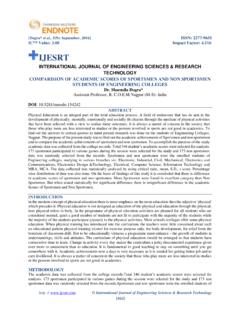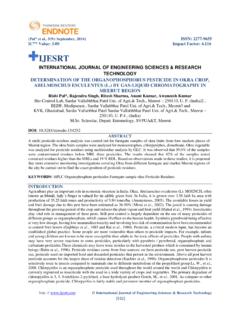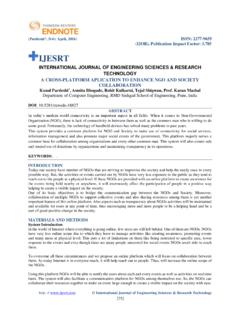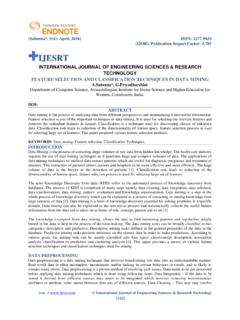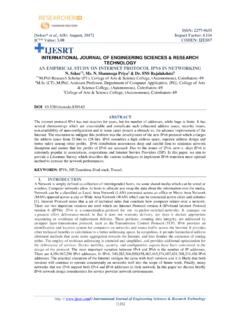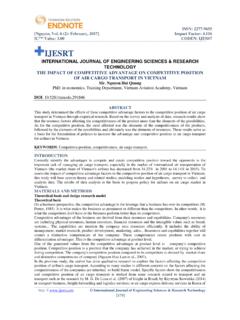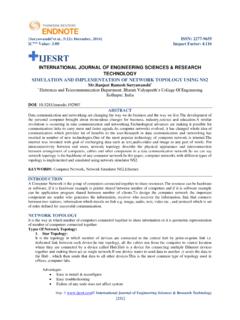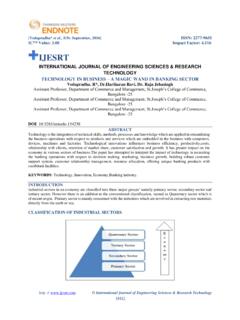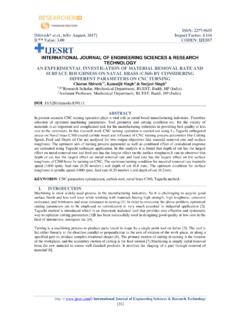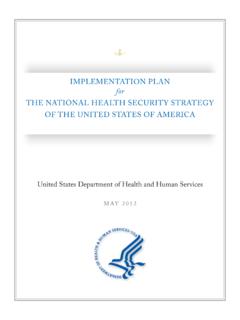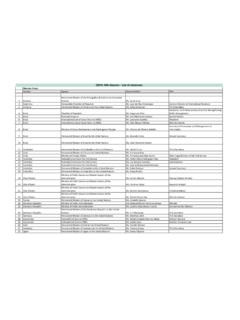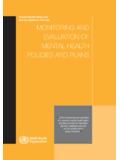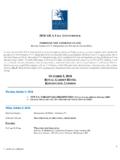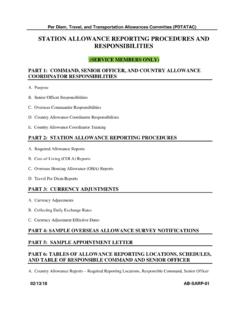Transcription of ENERGY EFFICIENT LEACH PROTOCOL IN WSN - IJESRT
1 [Gupta*et al., 5(9): September, 2016] ISSN: 2277-9655 IC Value: Impact Factor: http: // International Journal of Engineering Sciences & Research Technology [390] IJESRT INTERNATIONAL JOURNAL OF ENGINEERING SCIENCES & RESEARCH TECHNOLOGY ENERGY EFFICIENT LEACH PROTOCOL IN WSN Swati Gupta *, Gaurav Banga *Research Scholar, Master of Technology, ECE Department, GIMT, KKR, India Assistant Professor, ECE Department, GIMT, KKR, India DOI: ABSTRACT A sensor node hold small amount of resources in terms of processor, battery power, memory and communication range, but when a huge number of sensor nodes work together they are able to complete a good volume of task. It is just because of Wireless Sensor Network we are able to cooperate with physical world directly. In this context, hierarchical routing protocols offer ENERGY -efficiency, scalability and reliability for WSN applications.
2 With this goal in mind, this paper proposes to approve a Cluster-based approach for ENERGY -efficiency in the WSN (REER) PROTOCOL . The main purpose of REER is to provide ENERGY -efficiency by using for cluster formation and a probability function for Cluster Head election. Simulations were conducted to show the benefits of REER compared with LEACH . KEYWORDS: LEACH PROTOCOL , DD LEACH ,S LEACH , REER INTRODUCTION Wireless Sensor Networks (WSNs) [1] are networks of light-weight sensors that are battery powered consumed majorly for monitoring purposes. WSNs are growing equipped to handle some of these complex functions, in-network dispensation such as data aggregation, information fusion, computation and transmission activities requires these sensors to consume their ENERGY efficiently in order to extend their effective network life time.
3 Sensor nodes are ready to ENERGY drainage and failure, and their battery source might be irreplaceable, instead new sensors are deployed. Thus, the stable re-energizing of wireless sensor network as old sensor nodes die out and/or the uneven terrain of the scope being sensed can lead to ENERGY imbalances or heterogeneity among the sensor nodes. This can negatively impact the stability and execution of the network system if the extra ENERGY is not properly utilized and leveraged. Various clustering schemes and algorithm such as LEACH , DEEC, have been proposed with varying objectives such as load equilibrate, fault- tolerance, increased connectivity with reduced delay and network longevity. In recent years wireless sensor networks (WSNs) [2] has gained much attention due to the increase demand in the field of medicine, battle fields, identification of contaminated environments, environmental monitoring, analysis of structural conditions of buildings, roads and highways etc.
4 These networks are distributed embedded system consisting of large collection of short range sensor nodes collectively work together to monitor a system or an environment. These nodes will sense, and gather information from the environment or system and transmit the data to Base Station. The nodes consist of the sensor module which senses the environment, the processor and memory which perform local computation on the sensed data and store data, the transceiver responsible for exchange information with neighbour nodes and a power supply unit for node s ENERGY . This node architecture is shown in Figure 1. [Gupta*et al., 5(9): September, 2016] ISSN: 2277-9655 IC Value: Impact Factor: http: // International Journal of Engineering Sciences & Research Technology [391] Figure 1: Node architecture EXISTING TECHNIQUES OF LEACH PROTOCOL To overcome limitations of the LEACH [3], some improvements have been incorporated into the LEACH PROTOCOL .
5 Few improved routing protocols are: TL- LEACH , M- LEACH and DD- LEACH . These are hierarchical and more advanced over LEACH PROTOCOL , dissipate less ENERGY as compared to LEACH and provide prolonged lifetime. All these improved protocols use clustering. Clustering has an advantage over other algorithms due to following reasons: minimization of ENERGY consumption of intra-cluster as well as inter-cluster network, scalability of the network, prolonged network life time, reduction in information packet delay, and handling heterogeneity in the network. DD- LEACH PROTOCOL It is a combination of LEACH [3], a hierarchical based PROTOCOL and directed diffusion, a data-centric dissemination PROTOCOL . It supports two levels. At the first level, LEACH model is used and at the second level, directed diffusion model adopted. As in LEACH PROTOCOL , cluster formation is done, CH is particular over a cluster and TDMA schedule is distributed among nodes by CH.
6 After undergoing setup and steady state phases, the BS transmissions the query to the nearby CHs and those CHs in turn pass the query to other CHs. Hence the interest is communicated between all the CHs. The CHs act on the bases of the query received and forward the data to the BS. The CH forms a ramp with a nearby CH in order to communicate to the BS. The CH does not send data directly to the BS but through the protected path. The CH forwards only the aggregated query related data. Hence, considerable ENERGY is well-maintained, and also due to the fact that the CHs are not communicating to the BS directly. LEACH -C PROTOCOL LEACH -C [4] is also a cluster based PROTOCOL that uses a centralized clustering algorithm. The clusters are formed by the BS. Each node sends information about its current location and ENERGY level to the BS. The BS computes the regular node ENERGY , and whichever nodes have ENERGY below this average cannot be cluster-heads for the current round.
7 Using the residual nodes as possible cluster-heads, the BS finds clusters using the simulated hardening algorithm to solve the NP-hard problem of finding k optimal clusters. This algorithm attempts to minimize the amount of ENERGY for the non-cluster head nodes to communicate their data to the cluster head, by minimizing the total sum of square distances between all the non-cluster head nodes and the closest cluster-head. Eventually, the BS broadcasts a message that covers the cluster-head ID for each node. The steady-state phase of LEACH -C is identical to that of LEACH . The problem with LEACH and LEACH -C is that it assumes that cluster-heads are uniformly distributed The main concept behind this PROTOCOL is that by using a centralized control algorithm better clusters can be formed by dispersing the cluster heads on the basis oftheir geographical position throughout the WSN.
8 That is the basic concept for LEACH -centralized ( LEACH -C) as shown in Figure 2. All nodes send information about their location (using a GPS receiver) and their amount of ENERGY left to the BS, during LEACH -C's setup phase. In addition to making ideal clusters for the WSN, the BS needs to make sure that all nodes distribute ENERGY evenly among themselves. [Gupta*et al., 5(9): September, 2016] ISSN: 2277-9655 IC Value: Impact Factor: http: // International Journal of Engineering Sciences & Research Technology [392] Figure 2: LEACH -C Architecture SLEACH This is the first[5] modified secure version of LEACH called SLEACH, which investigated the problem of adding protection to cluster-based communication PROTOCOL for homogeneous wireless sensor networks involving of sensor nodes with strongly limited resources.
9 SLEACH provides protection in LEACH by using the structure block of SPINS (Security PROTOCOL for Sensor Network), symmetric-key methods and MAC (Message Authentication Code). SLEACH protects beside selective forwarding, sinkhole and HELLO flooding attacks. It prevents intruder to send factitious sensor data to the CH and CH to forward phony message. But SLEACH Cannot prevent to crowd the time slot agenda of a cluster, causing DoS attack or merely lowering the throughput of the CH and does not assurance data confidentiality. The solution is meant to protect only outsider attack. RLEACH Secure solution [5] for LEACH has been introduced called RLEACH in which cluster are formed dynamically and periodically. In RLEACH the orphan node problem is higher due to random pair-wise key scheme so they have applied improved random pair-wise key scheme to stunned.
10 RLEACH has been used the one way hash chain, symmetric and asymmetric cryptography to endow protection in the LEACH Hierarchical routing PROTOCOL . RLEACH protest many attack like spoofed, alter and replayed information, sinkhole, worm- hole, selective furthering, HELLO flooding and Sybil attack. PURPOSED ALGORITHM REER algorithm details The operation of REER is broken upon in to some steps, where initial step is cluster building stage, after building of clusters second step is election of cluster head based on cost value calculations which is calculated by some random node chosen as supervisor node outside the cluster followed by third step which is data transmission phase in which data is transmitted from that supervisor node to the base station and alteration of cluster is done based on packet loss ratio calculated by supervisor node itself.
